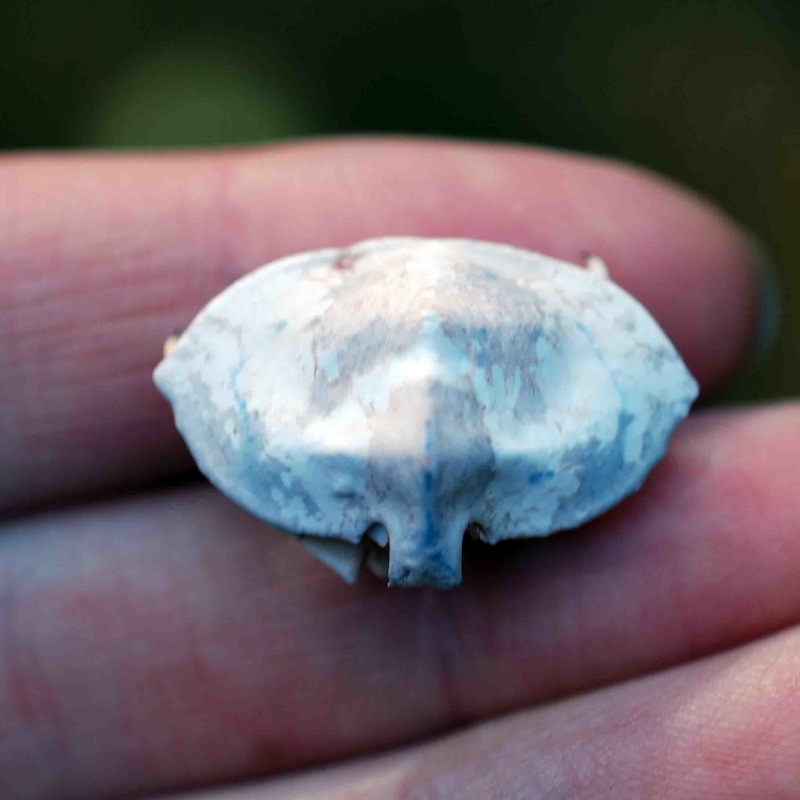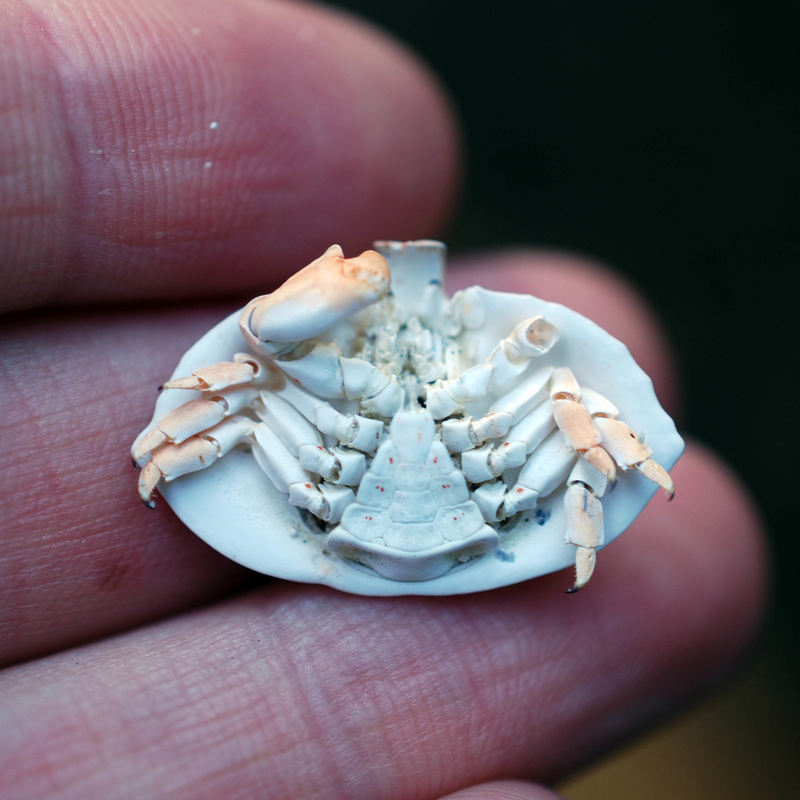Umbrella crab, turtle crab, Sitka crab • Cryptolithodes sitchensis
Identification
The laterally expanded carapace of this crab hides its legs and claws from view, so that when viewed from above the crab may appear like a rock or a piece of bivalve shell. The carapace colour varies greatly and may or may not be uniform: it can be bright orange or red, pink, purplish, dull grey or white, multicoloured, mottled or patterned, or with contrasting carapace "wings." It gets to 10 cm wide.
Habitat & Range
The umbrella crab is found in rocky intertidal and subtidal areas usually on wave-swept, exposed shorelines. It is found to depths of 37 m. It hides in crevices and on rock covered with encrusting algae and animals; when the crab remains still it can blend in with these surroundings quite successfully. The umbrella crab's range extends from southern Alaska to southern California.
Similar Species
The umbrella crab can be differentiated from the similar butterfly crab (Cryptolithodes typicus) by a few key characteristics. The butterfly crab's claws are roughened with tubercles, its abdominal plates have raised edges, and its rostrum is widest at the base. In contrast, the umbrella crab has smooth claws and abdominal plates, and its rostrum widens or flares at the tip. Additionally, the butterfly crab may be found in protected areas with high currents as well as exposed habitats.
The laterally expanded carapace of this crab hides its legs and claws from view, so that when viewed from above the crab may appear like a rock or a piece of bivalve shell. The carapace colour varies greatly and may or may not be uniform: it can be bright orange or red, pink, purplish, dull grey or white, multicoloured, mottled or patterned, or with contrasting carapace "wings." It gets to 10 cm wide.
Habitat & Range
The umbrella crab is found in rocky intertidal and subtidal areas usually on wave-swept, exposed shorelines. It is found to depths of 37 m. It hides in crevices and on rock covered with encrusting algae and animals; when the crab remains still it can blend in with these surroundings quite successfully. The umbrella crab's range extends from southern Alaska to southern California.
Similar Species
The umbrella crab can be differentiated from the similar butterfly crab (Cryptolithodes typicus) by a few key characteristics. The butterfly crab's claws are roughened with tubercles, its abdominal plates have raised edges, and its rostrum is widest at the base. In contrast, the umbrella crab has smooth claws and abdominal plates, and its rostrum widens or flares at the tip. Additionally, the butterfly crab may be found in protected areas with high currents as well as exposed habitats.
References
Cowles, D. (2005). Cryptolithodes sitchensis Brandt, 1853. Invertebrates of the Salish Sea. Rosario Beach Marine Laboratory. Accessed 03/07/2015.
Hart, J. (1984). Cryptolithodes sitchensis Brandt, 1953. In Klinkenberg, Brian. (Editor) 2012. E-Fauna BC: Electronic Atlas of the Fauna of British Columbia. Lab for Advanced Spatial Analysis, Department of Geography, University of British Columbia, Vancouver. Accessed 03/07/2015.
Lamb, A., and Hanby, B. (2005). Marine Life of the Pacific Northwest. Madeira Park, BC: Harbour Publishing. P. 302.
Jensen, G.C. (1995). Pacific Coast Crabs and Shrimp. Monterey, CA: Sea Challengers. P. 71.
Authors and editors of page
Kelly Fretwell and Brian Starzomski (2015).
Cowles, D. (2005). Cryptolithodes sitchensis Brandt, 1853. Invertebrates of the Salish Sea. Rosario Beach Marine Laboratory. Accessed 03/07/2015.
Hart, J. (1984). Cryptolithodes sitchensis Brandt, 1953. In Klinkenberg, Brian. (Editor) 2012. E-Fauna BC: Electronic Atlas of the Fauna of British Columbia. Lab for Advanced Spatial Analysis, Department of Geography, University of British Columbia, Vancouver. Accessed 03/07/2015.
Lamb, A., and Hanby, B. (2005). Marine Life of the Pacific Northwest. Madeira Park, BC: Harbour Publishing. P. 302.
Jensen, G.C. (1995). Pacific Coast Crabs and Shrimp. Monterey, CA: Sea Challengers. P. 71.
Authors and editors of page
Kelly Fretwell and Brian Starzomski (2015).






